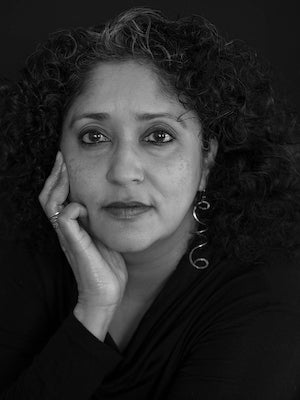Our faculty engage in cutting-edge research and produce innovative creative works every day as they bring new ideas to our students and our communities locally and globally. We’re pleased to continue this monthly spotlight series featuring our faculty’s work through a question-and-answer style article published on the first Friday of every month during the academic year.
Featured creative work: Solo exhibition, Newport Art Museum (September 2021-January 2022), Annu Matthew, Department of Art and Art History
Q: Please tell us about your solo exhibition at the Newport Art museum this fall, and elaborate on how it connects to current events:
A. I am excited that my solo exhibition at the Newport Art Museum premieres “UNREMEMBERED- Indian soldiers from World War II.” The installations are about the under-appreciated history that two and a half million Indians had stepped forward and volunteered to take up arms for their British colonial rulers. I did this work during my sabbatical, supported by a Fulbright fellowship.
The work connects to current events as we are at a moment in which memorials and histories are being re-evaluated and reconsidered in significant ways. Art can play a crucial role in shaping the politics of remembrance, “to understand the past to live a better future.” (quote from Dr. Daina Ramey Berry, PBS Newshour, February 5, 2021)
Why do you believe photo-based artwork best explores cultural histories?
Photo-based artwork is not the only way to explore cultural histories. My interest comes from the fact that photography is intrinsically connected to history and memory—an actuality I use as a tool to prompt the viewer to reconsider their notions of histories. Also, many of my projects start with images from media to engage a larger audience with something that initially appears to be familiar. Many of those projects start with photographs for what they initially represent and what they often hide. My artistic intervention questions the viewers’ assumptions to re-view history.
Q: Congratulations on your promotion to Full Professor III! What are some highlights from your tenure at URI so far?
Thanks! My top highlights are:
– My tenure at URI started with the administration trying to move mountains to rescue me from a visa disaster! I will forever be grateful for their unquestioning support.
– Another highlight of the last two decades is when past students still keep in touch.
Serving on the executive committee of the URI Center for the Humanities and then being Director for six years influenced my creative work to become more interdisciplinary, which also got me out of my discipline silo. That experience has enriched my time at URI.
– Grants from the Division of Research led me to experiment with digital imaging’s ever-expanding toolbox, thus ensuring that my teaching and creative work have not become stagnant.
– Now, as Full III, I’m not done! I’m excited to continue my mentorship of minority faculty, formalize my inspiring collaboration with Professor Richard Sheridan by teaching our class on Visualizing Climate Change, and continue, as Dean Riley wrote in her letter supporting my promotion, “offering…gentle critique.”
For students looking to study photography, what advice would you give?
My answer is informed by having studied in three countries and taught in many more. Today, with the proliferation of cell phones, everyone is a photographer! And we live in an ever-increasing visual world. My advice is that if students only want to learn techniques, search the web! So why study photography? The analogy that I give is that our students benefit from an English class. It helps hone their skills which enables them to write more eloquently to get their message across. Today everyone is a “photographer.” How does one create images that go beyond a cliché? After learning the building blocks of “seeing” photographically, my advice is to start teasing out the concepts and experiment to communicate visually. As a professor, I can help them choose the right tools to do so effectively. What I love about a university setting is that our students come from multiple disciplines and backgrounds. These interests and content reflect strongly in their work. So try and double major!
See more from Professor Matthew here.
This month’s spotlight was organized by Taylor Petrini ’20

